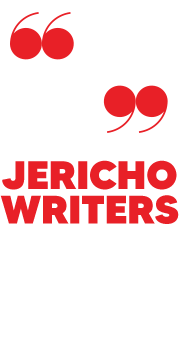An easy template | Loads of writing descriptions examples | A flood of sales …
You’ve lured readers to your book page. Congratulations.
Maybe, your stunning cover art has done it. Or a great title. Or a really well-constructed email campaign. Either way, you’ve got readers where you want them. They’re curious. They’re interested. But . . . they’re also suspicious.
Don’t get me wrong. I’m not saying those potential readers are unusual in any way.
Quite the reverse. They’re like you or me. Sure a $2.99 ebook isn’t a huge purchase decision – but a dollar is a dollar, and we value our time, and no one wants to buy a book that doesn’t grab them.
And that’s why your book description is so intensely important: a vital member of the Fab Four of sales conversion.
A strong description may make a reader buy the book or, perhaps more likely, go to the “Look Inside” feature which gives them more data on which to base their decision. And that really is the task of your book description: make readers click “Look Inside”. If you do that, you’ve won. Keep reading to find out how to write such a description.
(Oh, and before we go further, I should say that the basic description writing template we’re about to lay out works for both novels and non-fiction – but it produces very different results in both cases. Bear with me, because we’ll look at both.)
The Sales Pathway
In fact, if you like to visualise the complete sales journey on Amazon (and excluding a ton of complicating factors), then it looks like this.
Amazon Search Page ⇒ Your Book Page
Key conversion factors: Cover, Price, Reviews (total number)
Supporting cast: Title, Reviews (average rating)
Your Book Page ⇒ Look Inside
Key conversion factors: Book description
Supporting cast: Cover, reviews
Look Inside ⇒ Buy Now
Key conversion factors: The book itself!
Supporting cast: Cover, book description, Reviews, Price
Every step of that pathway is critical, except of course that in some cases the book page will push users straight to the Buy Now button.
(Although, who actually makes purchase decisions that fast? You do if you’re buying Lee Child #97, because you’re already a keen fan of Lee Child #1-96. You do if you’re buying a “How To” style non-fiction book and you know that this author and this topic will meet your needs.
But mostly? Mostly, I think, users want to try before they buy with authors who are new to them, and that means it helps you to visualise your sales journey in three steps, not two.)
What Your Amazon Book Description Has to Do
So, OK, your book description has to push people into hitting that “Look Inside” feature. That’s the step which defines success. But how do you actually accomplish that goal? How do you write Amazon book descriptions that really sell the book and compel the reader?
To answer that question, you have to get a clear read on your who reader is – what their state of mind is.
So let’s say, like me, you are a crime novelist. I’m going to assume that you’ve set your keywords and categories correctly. (Not sure about them? Check here for guest blogger, Dave Gaughran’s super-expert guide.)
So, if you’ve done things right to this point, your book should start popping up in front of readers who:
(a) have come to Amazon looking for a book,
ie: they have real purchase intent – they want a crime novel
(b) are interested in your genre,
that’s how come your work is showing up in their searches, but
(c) don’t know anything specific about you or what you’ve written
Your great cover and great reviews persuade those people to click through to your book page.
And these people are your perfect customers, in the sense that they have an immediate purchase-intent and they want a crime book. But
- They’re impatient
Because this is the internet, and everyone is impatient. - They need information about what you’re offering
Because you as an author are new to them, and they need help in understanding your product. - They need to understand why they should buy your product
Because they need you to answer the question, “What will this book do for me? What will I get from it?”
And finally of course:
- They want to be blown away
They want to find themselves trapped in a place, where the only way out is to read your book. (And they probably need to be nudged towards that course of action.)
So how exactly do you do it? How do you nudge the reader to set out on a book-length journey with you . . . when you only have maybe 150 words to convince them to take the trip?
How to Take The Reader With You . . . In 150 Words or Less
We’ve said that readers are impatient (it’s them that set that 150 word limit, not Amazon.) So you have to achieve a lot in a very short space of time . . . and here’s the basic template you need to follow.
First, you need (1) to hook your readers in your first or second sentence.
Then you need to (2) provide more data about what kind of book you’re offering. (Yes, a crime book, in our example, but police procedural? Or violent gangland thriller? And set in a quiet English village? Or south central LA?)
And beyond that, you need to (3) give the reader a sense of what emotional payoff they’re going to get from your book. And that means that your reader actually needs to feel that payoff. Sure, there’s only so much emotion you can generate in a short space, but your readers understand the difference between the trailer and the movie. They understand the difference between the book description and the book.
Then finally, (4), you need to nudge your reader towards the next action (either “Buy Now” or “Look Inside”). I’m not a huge fan of really direct calls to action in a book description, but you can still tip the reader in the direction you want to take.
So that’s what our description has to accomplish. I’m about to tell you how to do it. Do just note that this is not a complete guide to the art of self-publishing. Luckily, though, we already have one for you, if you want it. It’s right here.
Your Amazon Book Description Template
The basic template for a book description is:
- Hook. This is one sentence, maybe two. Ideally, no more than that. If you go for three or more sentences, that can be fine . . . as long as they’re very short ones!
- Content. In the case of fiction, this will be a mini-story in its own right. In the case, of non-fiction, you will be laying out the substance of the book. In both cases, though, you’ll be answering the “what is this?” question and the “what will it do for me?” one. For fiction, your mini-story should run to about 75-100 words. Non-fictioneers can (and probably should) go long.
- Climax / call to action. If your main content is a mini-story, you want to end it on a cliffhanger, or a question, or some other place that is unsatisfying to the reader. In that sense, the cliffhanger IS your call to action. You’re effectively saying, “Hey, you don’t like being left in that place of suspense? Well, there’s only one way you can fix that problem, buddy . . . and the ‘Buy Now’ button is right up there.” You don’t even need to say that explicitly to say it. Oh, and the same basic approach works with non-fiction too. We’ll look at both. In terms of length, your climax is probably just one sentence. It could be two, but if so, they’re probably short ones . . .
To be clear, that template works for every book. It’s the heart of every successful book description ever.
We’re going to go on to look at some specific examples of how that template works out in practice, but before we get there, we have to face one more question.
Do you want a very clean, pared-down book description, of the sort that Amazon Publishing generally favours? (One example here.)
Or do you want to follow the kitchen-sink model favoured by Bookouture, an outstandingly successful British e-publisher? (One example of their monster book descriptions here – note the huge number of reviews etc included as part of that book description.
Personally, I prefer the latter model. I like the ability to hold the reader on “my” part of my book’s web real estate. So I want readers to look at the reviews that I choose to shove under their nose. I don’t want my reader wandering down to look at the “also boughts”. I want them to feel complete before they even reach the end of the book description.
But to be clear: that’s not the only method.
Amazon, in case you hadn’t noticed, is rather good at data, and if their publishing arm favours a very trimmed-down version of the book description, it clearly works for them. So you can go light, or you can go heavy . . . the one thing you can’t do is mess with that template.
The next thing for us to do? See how it works in practice.
This stuff is helpful, right?
But, you know, there’s a lot more where this came from. We’ve got an entire self-publishing video course, that’s expensive to buy (see details) . . . but which we’d like to give you totally free.
And not just that course, but an awesome on on How To Write. And live webinars with literary agents and top book doctors. And an incredible cinema, full of films by writers for writers.
In fact, our Jericho Writers club is made for writers like you – and was created by writers like you. We think you’ll be blown away by what we have on offer. To find out more, just Explore Our Club. We look forward to welcoming you soon.

Your Book Description: Some Examples
OK, you want an example of a top quality book description? Well, here’s one from Amazon imprint author, Mark Edwards. Mark writes his own descriptions and Amazon loves them so much, they don’t change a word. Mark opts for a super-pared down description and it works unbelievably well, as you can see.
Here’s an example from his BECAUSE YOU LOVE ME. (Here on Amazon.com, or here on Amazon UK.)
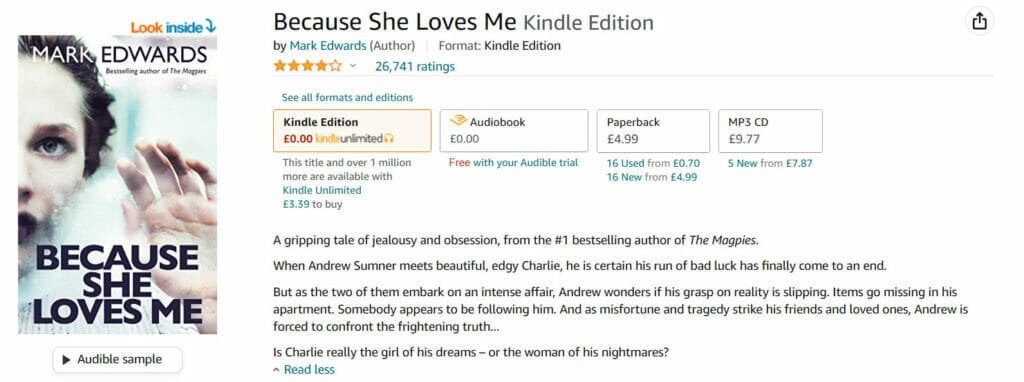
You can see that the hook / content / climax template is alive and well in that short piece of text. (Which totals just 100 words, by the way. I’d say that 100 words sits at the very short end of what you can get away with. Anything between 100 and, say, 180 words feels about right.)
In this case, the hook is simply: “this author is a #1 worldwide bestseller, and if you like stories about jealousy / obsession / murder, you’re probably in the right place.” Works for you? Yep, it works for me too.
Notice that that one short sentence has ticked two boxes. It’s said, “here are the themes of the book [so you already know what kind of emotional journey it’s going to offer.” But it’s also said, “And you don’t need to be worried about wasting your $3.99, because I’m a top author and you’re in good hands.”
The story here is delivered with extreme economy, but just look what it accomplishes.
That first sentence (Andrew meets Charlie) gives us the premise. In effect, that’s the initiating incident right there. In one sentence. Not just that, but you’re given the first uh-oh moment. (“He is certain his run of bad luck has finally come to an end.” You and I known damn well that it’s only just starting.)
With the starting position swiftly drawn, the story instantly escalates . . . things missing, a stalker, misfortune, tragedy. The issues start small and build fast. In effect, in the tiny world of this book description, Mark Edwards has succeeded in building a perfectly formed story.
What’s more, that little story answers the “what kind of book is this?” question. You just know exactly from the information you’ve been given.
But it answers the “what feelings will you have when reading it?” question too. You know exactly what your emotional payoff is going to be.
And then the climax / CTA: in this case, a question. Is this woman an angel – or a demon?
Notice that you don’t actually need to do anything as crude as say, “Hey, go and buy my book!” That would actually spoil the emotional place you’ve got the reader into. What you’ve done is smarter than just some crude “buy me” message. You’ve engineered a little emotional conflict in the reader. They want to know the answer to your angel / demon question . . . but the only way they can resolve that is to buy the book.
Don’t know about you, but that works for me.
Different Ways to Deliver Hook
Marks’s hook was a neat and uncomplicated one. Basically, “This book is a story about X, and you can trust that it’ll be a good one because I’m a #1 bestseller.”
That’s OK if you are a #1 bestseller. If you’re not? Well, there are a million other ways to do it:
- Social proof. (“Readers are raving about this book. ‘Awesome, gob-smacking.’ Annie J. ‘Breathtaking. I never wanted it to end.’ Jaco R.”)
- Formal proof. (“The New York Times called this book ‘dazzling’. The Washington Post said, ‘It’s so good, you’ll want to read it twice.’”)
- Question. (“Was she an angel? Or a demon?”)
- Provocation. (“Finally – a heroine to kick Lisbeth Salander’s ass.”)
- Comparison. (“If you loved Donna Tartt’s Secret History, you’ll love this tale of darkness, betrayal – and Homer.”)
- Premise / set-up. (“She was his ex-wife. He still loved her. But why was she driving the getaway car in Chicago’s biggest-ever heist?”)
- Sales. (“100,000 copies sold in the series. And fans rate this as the best one yet.”)
Or whatever! Be imaginative. Use whatever you’ve got. It doesn’t matter what type of hook you use. It does matter that you have one!
Different Ways to Deliver Your Climax / CTA
Likewise, your climax can operate in different ways.
- Choice / question. (“Was she an angel? Or a demon? Or – worse still – was she both?”)
- Suspense / cliffhanger. (“There was only one way to find out. And that was to open the tomb.”)
- Reminder of social proof / sales / formal proof. (“This is the novel that has sold a bazillion copies / that the New York Times raved about / that readers have awarded 100s of 5-star reviews.”)
- Comparisons nudge. (“Perfect for fans of Stephenie Meyer and Suzanne Collins.”)
Again, it doesn’t really matter what you do; it does matter that you choose to do it.
Personally, when it comes to fiction, I think you want to leave your readers in the story. That means the choice / question / cliffhanger ending works better for me than the jump back into “hey, the New York Times loved this”. But that could be a personal thing. Certainly you see plenty of competent indie authors / trad publishers using a whole variety of methods here.
One More Example
Just to show you how universal this model is, I’m going to give you an illustration from my own work – this one comes from the UK edition of my police procedural, THE DEAD HOUSE. I wasn’t in fact the primary author of this description – I just tweaked a description written by my publisher – but it’s probably the best of the descriptions of my work out there.
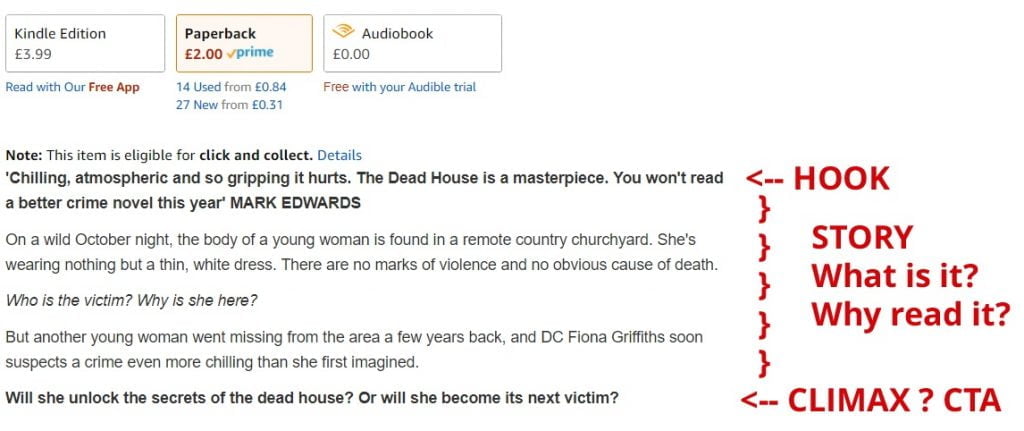
You’ll see how precisely that description follows our template.
The hook delivers a sense of emotion (“Chilling, atmospheric and gripping”), and a proof of quality – here’s top author Mark Edwards bigging the book up. (I’d forgotten, actually, that Mark had plugged The Dead House when I extracted his description above – but he’s a damn nice guy, with excellent taste . . . and he can write quite nicely too!)
The story / content builds from the premise (victim’s body found), adds some mystery (who is she? why is she here? what’s with the thin white dress?), then escalates is one more time (another woman went missing). All that in a space hardly longer than Mark Edwards’s super-economical 100 words.
And then the climax / CTA follows the template too: a question of the type that crime readers love.
In fact – big claim here – if you find ANY good book description on Amazon, you’ll find it follows the same basic template.
You don’t believe me? What about non-fiction, you cry?
Pshaw, says I, and fiddle-de-dee. It’s true of non-fiction too. I’m going to show you an example of that in just one moment – but first some very important remarks about formatting, and how to make the most of the 4000 character allowance that Amazon grants us for book descriptions.
Book Descriptions: Formatting, Length and Additional Content
If you’ve been thinking about book descriptions at all, you’ll have noticed that some descriptions make good use of formatting (bold, italics, subheadings, etc), some make wildly excessive use of them, and some make no use at all.
About Formatting
Although Amazon’s own imprints make almost no use of formatting (and those guys test extensively, so they’re not just being stupid or lazy), my own view is that some good, calm, tasteful formatting adds structure and intelligibility to the blurb.
I’m not going to talk in detail about how to insert bold and italics, etc. The short answer is that you use html tags like or to make text bold or italics respectively, and then lose the tags with, for example or , once you want the bold / italics to stop. But that’s not really a complete answer, so:
- You can read Amazon’s own guidelines here, but better still
- There’s a really easy tool here, which allows you to format your text on screen in a way that you’re happy with. Once you’re happy with the way your book description looks, you just hit “Get code” and the tool will deliver you with the text you can just cut and paste into your Amazon book description box. Simple! I’m happy enough using html tags, but I still use that tool, just because it’s easier to design nice-looking text if you can see what you get, real-time.
In short, my advice is DO use formatting, but carefully. I think both my DEAD HOUSE description and the Italian guidebook description we’re about to look at use those formatting tools in a nice, clear, helpful way.
But then another question looms.
It’s this: do you want your book description to look very short and sweet – like the Mark Edwards description we looked at first – or do you want it to segue from book blurb into a whole pile of reviews and the like?
Book Descriptions: Short Versus Long?
Compare the Mark Edwards book description here, with this one from Angela Marsons, who is published by hyper-successful British e-publisher, Bookouture.
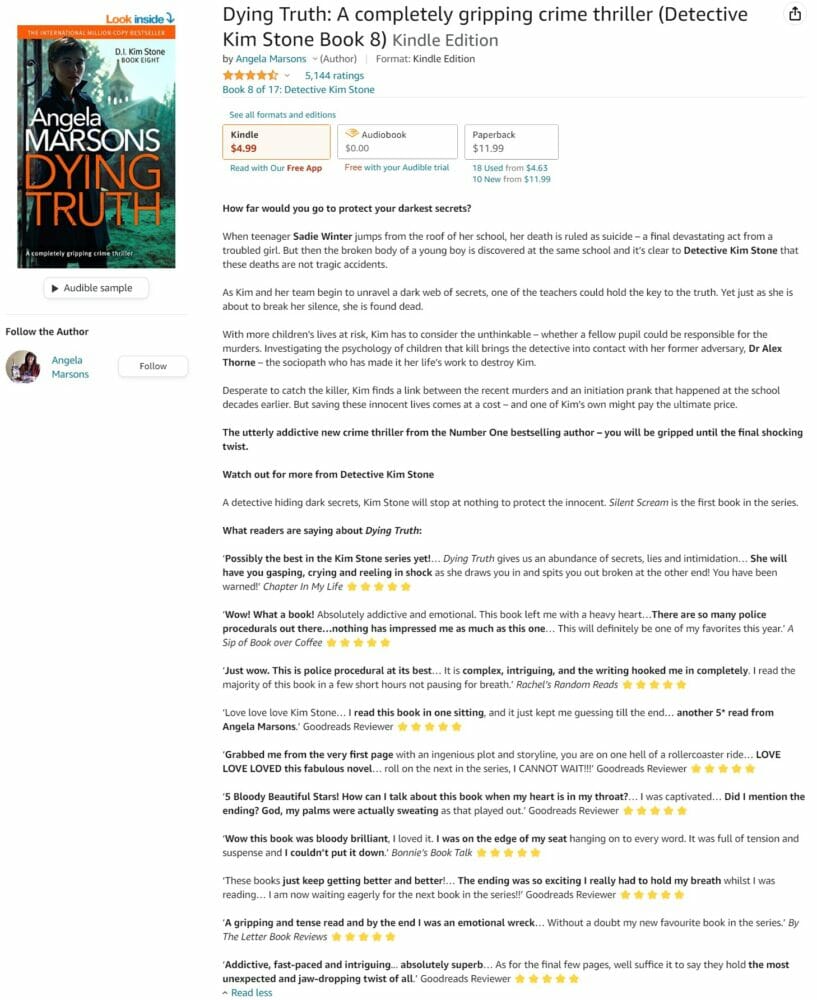
The Angela Marsons one follows our template at the start – so it has a blurb-like blurb with intro / story / climax like all the others. But then it tells us “Readers are loving Dying Truth” and lays out a whole set of reader / blogger / formal reviews.
Now there’s something interesting here. If you look at their records over the last several years, there’s a strong case to be made that Bookouture and Amazon are the world’s two best publishers when it comes to publishing and selling on Amazon’s KDP platform. They text extensively and monitor outcomes.
But one firm – Amazon – goes for extremely short, unformatted book descriptions. The other, Bookouture, goes for very long, highly formatted ones.
Which to prefer? Well, if you have two great firms making quite opposite choices, that says to me that both options work.
Personally, I prefer – and use myself – the Bookouture model, of conventional blurb followed by a ton of reviews, but it’s your call. There’s no absolute right and wrong here.
Using Formatting to Brand Your Book
Finally, do take a look back at that book description for Angela Marsons.
Notice the way that the publishers use formatting not just to say “this book is great”, but to ram home their key marketing messages for the book. So take this bit from the book description:
‘Just wow. This is police procedural at its best…It is complex, intriguing, and the writing hooked me in completely. I read the majority of this book in a few short hours not pausing for breath’ (5 stars) Rachel’s Random Reads
That quote (and use of bold) is reminding the reader that this book is a police procedural. In other words, it’s sending out the not-so-subtle message to readers who like police procedurals that this book could well be for them. So the perfect reviews to select for your book description will be ones that (a) say “this book is great”, but also (b) reinforce your basic message of what this book is and what the emotional payoff will be.
In effect, any reviews you include at the bottom of your book description should say, “You know that implicit promise from the blurb? About what you can expect to get from the book if you buy it? Well, trust me, buddy, this book will more than deliver for you.”
So the blurb part of the book description delivers a promise, and the review part of it affirms that other readers / reviewers consider that promise to have been met.
That’s a template that I personally like very much and use for all my self-published work.
Has This Been Helpful?
Before you leave this page – and just before we get to that long-promised non-fiction book description – may I ask you a question? It’s this:
Has this page been helpful?
And, because you’re an indie author, what that really means is:
Will you make more sales by using insights from this page?
Will you develop your career?
Will you look like – and be – a more professional author?
I’m really hoping that the answers to those questions are yes, yep, and you betcha.
In which case – why stop at one blog post? Why not go the whole hog? Because – did you know this? – we have an entire course on self-publishing that tells you everything you need to know in incredibly clear detail. It’s fun. It’s engaging. It’s comprehensive. And it will get you from zero to sixty in no time at all.
Basically, it’ll cut out all the mistakes and get you on the road to indie-dom fast and properly.
And yes, there’s a catch. But, panic ye not, there’s a way to sniggle your way past that catch without being snared.
So the catch is quite simply price. The course is a super-premium course and it costs hundreds of dollars to buy. (You can view the course outline in full here.) The price makes sense. You get 13 full length videos, plus a ton of bonus material too. Those videos come with full, extensive PDF-downloads, so you have notes on every topic at the click of a button. Unless you are a super-sophisticated indie author already, this course WILL make you a better, richer, happier author. It’ll basically cut out all the mistakes and trial-and-error decisions, and put you on the road to success.
But it’s expensive. So what to do?
The answer is: don’t buy it. Rent it. If you become a member of Jericho Writers, you get all the learning material on this site FOR FREE. All of it. There’s no limit to your access. So you can gobble up that video course, and all our self-published filmed masterclasses, and all our material on how to write, and everything else besides, and not pay one dime over your monthly membership fee.
You can learn more about Jericho Writers here or just sign up here.
What’s more, our membership is cancel-any-time, so you can just sign up, help yourself to whatever you want from our learning tools, then quit. We’d love it if you stayed, but if you don’t want to, that’s fine too.
We’re writers ourselves and we’re here to help.
Non-Fiction Book Descriptions – Also Formatting, Length & Reviews
The thing about non-fiction, is that you still need the hook, to draw readers into your page. You still need the springboard-style lift
So here, for example, is the book description from Rick Steve’s Italy – a guidebook that I’ve chosen to complement the beautiful images of the Italian landscape that adorn this post. Notice the enticing intro, the meaty content, and what is effectively a call-to-action right at the end.
Notice too the clever way this blurb moves from standard guidebook stuff (“top sights and hidden gems”) to things that make you start visualising yourself in Italy with this book in your pack (“Over 1000 Bible-thin pages”).
That’s the whole book description template in (beautifully formatted) action, right?
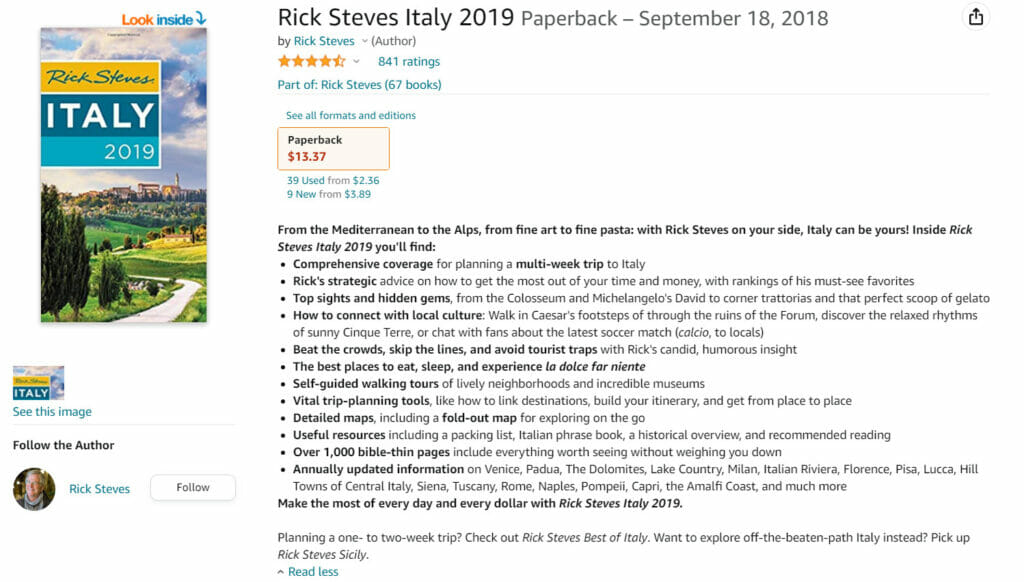
In fact, I hope that you can see our book description rules are basically universal. If they can cover dark crime fiction like mine / Mark Edwards’s / Angela Marsons’s AND a standard-issue Italian guidebook, then they just have to work everywhere, right?
So go write your book description, entice those readers and grab those sales!
Jericho Writers is a global membership group for writers, providing everything you need to get published. Keep up with our news, membership offers, and updates by signing up to our newsletter. For more writing articles, take a look at our blog page.











